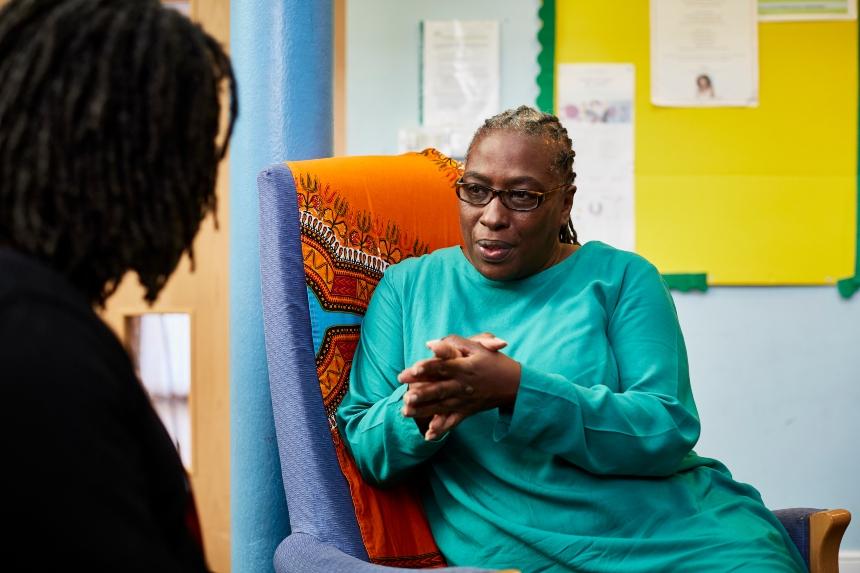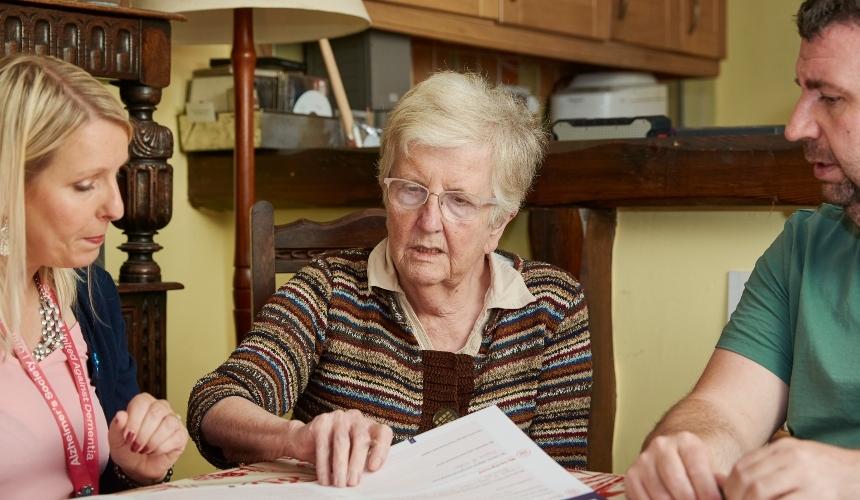What we think about dementia diagnosis
Find out what we think about dementia diagnosis rates in England, Northern Ireland and Wales, and our focus on early diagnosis and regional inequalities.

What we think
Getting a diagnosis can enable people living with dementia to plan for the future and gain access to care, symptomatic treatments, information, advice and opportunities to participate in dementia research.
Just 1% of people surveyed by Alzheimer's Society saw no benefit to getting a diagnosis. Yet right now, a third of people living with dementia in England and Northern Ireland and half of people living with dementia in Wales don’t have a diagnosis, meaning they’re missing out on all the benefits a diagnosis can bring. Despite all this, the equivalent of only 1.4% of total dementia healthcare spend goes on diagnosis and treatment.
This leaves people living with dementia and their families at risk of crisis, such as unplanned hospitalisation, which can have an adverse effect on their health and wellbeing, as well as the wider health and social care system.
We need to see clear action on:
- Bold, ambitious and achievable new diagnosis rate targets must be set by Governments and health systems in England, Wales, and Northern Ireland. These targets should be bolstered by public awareness campaigns to encourage people to seek a diagnosis, and support must also be provided to local systems to deliver on targets set.
- Making the case for improvements to diagnosis to ensure that in future, everyone living with dementia can access an early, accurate diagnosis if they want it, including information on the type of dementia they have.
- Steps must be taken to tackle the regional inequalities and postcode lottery in dementia diagnosis. We know that diagnosis rates vary significantly from place to place, with dementia prevalence also nearly twice as high for those living in the most deprived areas compared to the least deprived areas
- Plans must be published in England, Wales and Northern Ireland on how the NHS and HSC system will deliver disease-modifying treatments, including a specific focus on diagnosis.
Background
Dementia diagnosis rates across the UK are too low:
- the estimated dementia diagnosis rate in England is 65.2% as of July 2024
- the estimated dementia diagnosis rate in Wales is 56% as of April 2024.
- the estimated dementia diagnosis rate in Northern Ireland is 55% as of March 2024.
All fail to reach the modest national target of 66.7%.

The challenges
The main driver for a dementia diagnosis is to facilitate access to care and support to help people manage with this complex condition. However, with the fall in diagnosis rates, it is estimated that there are over 250,000 people in England alone who do not have a diagnosis.
Without a diagnosis, people affected by dementia are left to cope alone without any of the support that a diagnosis unlocks. Many are missing out on months – and in some cases years - of getting care, support and drugs to relieve their symptoms.
With the advent of potential new disease modifying treatments, and new diagnostic tools such as blood tests, it is vital that we can deliver the good quality, timely and accurate diagnoses needed for people to take advance of new treatments.
There is currently inequity of access to diagnosis services, including brain scans and other diagnostic technology. The latest National Audit of Dementia states that 23% of memory assessment services are not able to refer for specialist investigations, such as PET scans, 12% for DAT scans, 56% for CSF examination and 22% for SPECT scans (which are all different methods of diagnosing dementia subtypes). Furthermore, in those services that could refer patients, just 2.1% of all patients had a specialist investigation carried out.
Inadequate data hampers improvement efforts. There is no centrally collected data on diagnostic system capacity, waiting times from referral to diagnosis, and access to brain scans. Without proper data collection and publication, it is difficult to apportion resources.
There are a number of benefits that people living with dementia could access from participating in research trials, but when they are diagnosed, they are often not given enough information about how to sign up.
It is important that people have the option of joining research trials at the earliest stage possible, as trials often require people to be at specific stages in their dementia. There are further concerns about geographical inequalities and research trials not being distributed evenly across the country.
We also know that people do not get the post-diagnostic support they need. Unmet post diagnostic support need increases the risk of adverse, costly and detrimental outcomes such as hospitalisation, carer breakdown and more rapid admittance to care homes for people affected by dementia.
Typically, a person living with dementia will be diagnosed in a memory assessment service, being discharged back to their GP for ongoing care, support and treatment. This post-diagnostic support is usually defined as “holistic, integrated continuing care in the context of declining function and increasing needs of family carers.” Our 2022 report Left to Cope Alone found that a lack of guidance around post-diagnostic support is leading to a “postcode lottery of access to effective care and support,” leading many people living with dementia and their families struggling to access the help they need. In turn, this increases the risk of adverse, costly and detrimental outcomes such as hospitalisation, carer breakdown and more rapid admittance to care homes for people affected by dementia. The NICE guideline for dementia states that dementia specialists should be involved in ensuring appropriate access to post-diagnostic support and treatment, and we want to see this adhered to in practice.
What change do we want to see?
We want to see changes at a national level in all three nations, at a local level and around new diagnostic techniques and treatments.
At a national level in each of the three nations we need:
- In England, the Major Conditions Strategy must include a commitment to recovering diagnostic rates to pre-pandemic levels and then to go further. This requires a minimum of £70m investment to increase rates, audit memory services to understand regional and national backlogs and support primary care to implement innovative practice.
- We need to see work with stakeholders to identify an appropriately ambitious diagnosis rate target for the next three, five, seven and ten years, alongside an implementation plan to achieve it.
- We need to see improvement in centrally collected data and this should be published for all three nations.
- The implementation of the Regional Dementia Care Pathway to improve diagnosis rates, waiting times and adult social care reform in Northern Ireland. We want to see dementia prioritized, and pathways developed to ensure good links between primary and secondary care, and support to move between these settings.
- Better recognition of dementia amongst the public and general practice is also needed, along with timely assessments at secondary care level, including access to scans and multidisciplinary assessment support through the diagnostic and post-diagnostic process. Finally, better data collection including waiting times for first appointments and for scans and recording of sub type diagnosis across the three nations.
- Additional funding to support the National Dementia Action Plan companion document in Wales. Including a timely and accurate diagnosis and implementation of post-diagnostic support, in addition to re-committing to the target for Local Health Boards to increase diagnosis rates by 3% per year.
- National health systems must invest in infrastructure and workforce to enable access to new diagnostic tools and disease modifying treatments (DMTs). A blood test which can measure levels of beta-amyloid, a protein that accumulates abnormally in people with Alzheimer’s disease, must be widely implemented within the NHS. Patients with Alzheimer’s disease must have access to an amyloid PET scan or a cerebrospinal fluid (CSF) test to confirm eligibility for the potential new medication.
- Greater investment in development and implementation of diagnostic techniques to spot the early signs of dementia and accurately identify dementia subtypes such as vascular or frontotemporal dementia.
- When new treatments are rolled out, scanning capacity to account for continued access to brains scans to monitor safety. New treatments must not divert resources away from diagnosing and supporting those with other types of dementia.
- Local systems across the three nations to prioritise dementia, including through comprehensive dementia strategies that commit to returning the local diagnostic rate to at or above two-thirds.
- The innovative work already going on to improve the timeliness and accuracy of a dementia diagnosis to be understood, shared and replicated across local health care systems.
- The collection of data to better understand diagnosis pinch points including the collection of trust/board-level diagnosis waiting lists and patient waiting times from GP referral to diagnosis needs to be improved.
How is dementia diagnosed?
Read information on getting a dementia diagnosis, including what to expect from tests and scans.
- Page last reviewed:


Whilst raising diagnosis rates is important, it is vital that people also receive a good quality, timely and accurate diagnosis, delivered with a confirmation of their dementia type, enabling some people to access disease modifying treatments (DMTs), once available.
DMTs such as Lecanemab and Donanemab will only be available to people in the early stages of Alzheimer’s disease. Investment in, and the implementation of, existing and new diagnostic techniques are required to improve the quality, timeliness, and accuracy of a diagnosis, including access to blood tests and brain scans.
There is also significant regional variation in diagnosis rates. In England, diagnosis rates vary across integrated care systems from 75.6% (South Yorkshire ICB), to 54.5% (Herefordshire and Worcestershire ICB).
In Northern Ireland and Wales there isn’t sufficient data available to enable a comparison of diagnosis rates at a local level. Furthermore, beyond diagnosis rates, there is insufficient local data available in any of the three nations on quality, timeliness or accuracy of a dementia diagnosis, making it hard to quantify the scale of the postcode lottery people face in accessing quality diagnosis.
In 2022, we convened key stakeholders from the three nations, including researchers, clinicians, people living with dementia and decision makers to explore the barriers to diagnosis, and to form a consensus on what needs to happen to improve access to a timely and accurate diagnosis of dementia.
Barriers identified included workforce capacity, diagnostic pathway design, funding arrangements, public health messaging and regional variation. The report and consensus statement can be read online. We continue to share these recommendations with the NHS and governments and they will inform policymaking and practice at both a national and local system level.